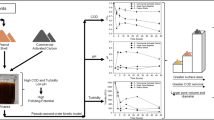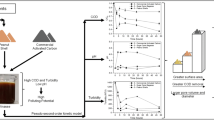Abstract
The main objective of this study was to produce, under pilot conditions, activated carbons (AC) from two different Caribbean by-products, specifically, sugarcane bagasse and vetiver roots. The produced activated carbons under both physical and chemical activation processes were characterised with respect to their texture and surface chemistry. The textural and chemical analyses showed that the nature of the precursor played a crucial role in determining the main characteristics of the activated carbon that was produced. Indeed, under the pilot production chemical activation conditions, bagasse-derived AC (“Bag-pilot”) showed the highest specific surface area (i.e. Brunauer, Emmett and Teller surface, SBET) with 1,030 m2/g compared to 555 m2/g for vetiver-derived AC (“Vet-pilot”). Porous texture analysis revealed that “Bag-pilot” developed more volume (0.807 cm3/g) than “Vet-pilot” (0.352 cm3/g), whereas “Vet-pilot” displayed more micropores (27 %). As for the surface chemistry, results showed that “Bag-pilot” contain more acidic and basic groups than “Vet-pilot” which makes it more interesting for adsorption purposes. The cost estimate of producing AC from vetiver roots in Haiti revealed that the chemically activated carbon presented the lowest cost at $1.17 per kg compared with 1.46$ per kg for physically activated carbon.






Similar content being viewed by others
References
Altenor, S.: Physicochemical studies of algae and activated carbons derived from the Caribbean and their applicability for water treatment. PhD Thesis, University of Antilles and Guyane (2008)
Lavania, U.C.: Central Institute of Medicinal and Aromatic Plants, Lucknow, other uses, and utilization of vetiver: vetiver oil. http://www.vetiver.com/ICV3-Proceedings/IND_vetoil.pdf Accessed September 2012
Caribbean Office of Trade Negotiations: CARICOM’s essential oils trade, private sector trade note, vol. 9. http://www.crnm.org Accessed September 2012 (2009)
Valix, M., Cheung, W.H., McKay, G.: Preparation of activated carbon using low temperature carbonisation and physical activation of high ash raw bagasse for acid dye adsorption. Chemosphere 56, 493–501 (2004)
Jung, M.W., Ahn, K.H., Lee, Y., Kim, K.P., Rhee, J.S., Park, J.T., Paeng, K.J.: Adsorption characteristics of phenol and chlorophenols on granular activated carbons (GAC). Microchem. J. 70, 123–131 (2001)
Juang, R.S., Wu, F.C., Tseng, R.L.: Characterization and use of activated carbons prepared from bagasses for liquid-phase adsorption. Colloid. Surf. A Physicochem. Eng. Aspects 201, 191–199 (2002)
Tsai, W.T., Chang, C.Y., Lin, M.C., Chien, S.F., Sun, H.F., Hsieh, M.F.: Adsorption of acid dye onto activated carbons prepared from agricultural waste bagasse by ZnCl2 activation. Chemosphere 45, 51–58 (2001)
Ahmedna, M., Marshall, W.E., Rao, R.M.: Production of granular activated carbons from select agricultural byproducts and evaluation of their physical, chemical, and adsorption properties. Bioresour. Technol. 71, 113–123 (2000)
Cronje, K.J., Chetty, K., Carsky, M., Sahu, J.N., Meikap, B.C.: Optimization of chromium(VI) sorption potential using developed activated carbon from sugarcane bagasse with chemical activation by zinc chloride. Desalination 275, 276–284 (2011)
Altenor, S., Carene, B., Emmanuel, E., Lambert, J., Ehrhardt, J.J., Gaspard, S.: Adsorption studies of methylene blue and phenol onto vetiver roots activated carbon prepared by chemical activation. J. Hazard. Mater. 165, 1029–1039 (2009)
Arami-Niya, A., Daud, W.M., Mjalli, F.S.: Comparative study of the textural characteristics of oil palm shell activated carbon produced by chemical and physical activation for methane adsorption. Chem. Eng. Res. Design 89, 657–664 (2011)
Barret, E.P., Joyner, P.B., Halenda, P.: The determination of pore volume and area distributions in porous substances. I. Computations from nitrogen isotherms. J. Amer. Chem. Soc. 73, 373–380 (1951)
Diaz-Diez, M.A., Gomez-Serrano, V., Fernandez-Gonzalez, C., Cuerda-Correa, E.M., Marcias-Garcia, A.: Porous texture of activated carbons prepared by phosphoric acid activation of woods. Appl. Surf. Sci. 238, 309–313 (2004)
Ng, C., Marshall, W.E., Rao, R.M., Bansode, R.R., Losso, J.N.: Activated carbon from pecan shell: process description and economic analysis. Ind. Crops Prod. 17, 209–217 (2003)
Lima, I.M., McAloon, A., Boateng, A.A.: Activated carbon from broiler litter: process description and cost of production. Biomass Bioenergy 32, 568–572 (2008)
Molina-Sabio, M., Rodriguez-Reinoso, F., Caturla, F., Selles, M.J.: Porosity in granular carbons activated with phosphoric acid. Carbon 33, 1105–1113 (1995)
Gratuito, M.K., Panyathanmaporn, T., Chumnanklang, R.A., Sirinuntawittaya, N., Dutta, A.: Production of activated carbon fromcoconut shell: optimization using response surface methodology. Bioresour. Technol. 99, 4887–4895 (2007)
Ncibi, M.C., Altenor, S., Seffen, M., Brouers, F., Gaspard, S.: Modelling single compound adsorption onto porous and non-porous sorbents using a deformed Weibull exponential isotherm. Chem. Eng. J. 145, 196–202 (2008)
Gupta, V.K., Gupta, B., Rastogi, A., Agarwal, S., Nayak, A.: Pesticides removal from waste water by activated carbon prepared from waste rubber tire. Water Res. 45, 4047–4055 (2011)
Brouers, F., Sotolongo, O., Marquez, F., Pirard, J.P.: Microporous and heterogeneous surface adsorption isotherms arising from Levy distributions. Phys. A 349, 271–282 (2005)
Dabrowski, A., Podkosicielny, P., Hubicki, Z., Barczak, M.: Adsorption of phenolic compounds by activated carbon: a critical review. Chemosphere 58, 1049–1070 (2005)
Radovic, L.R., Moreno-Castilla, C., Rivera-Utrilla, J.: Carbons materials as adsorbents in aqueous solutions. In: Radovic, L.R. (ed.) Chemistry and physics of carbon. A series of advances, pp. 267–269. Marcel Dekker, New York (2000)
Gaspard, S., Altenor, S., Dawson, E.A., Barnes, P.A., Ouensanga, A.: Activated carbon from vetiver roots: gas and liquid adsorption studies. J. Hazard. Mater. 144, 73–81 (2007)
Toles, C.A., Marshall, W.E., Johns, M.M., Wartelle, L.H., McAloon, A.: Acid-activated carbons from almond shells: physical, chemical and adsorptive properties and estimated cost of production. Bioresour. Technol. 71, 87–92 (2000)
Toles, C.A., Marshall, W.E., Johns, M.M., Wartelle, L.H., McAloon, A.: Steam- or carbon dioxide-activated carbons from almond shells: physical, chemical and adsorptive properties and estimated cost of production. Bioresour. Technol. 75, 197–203 (2000)
National statistics office, Dominican Republic, French embassy in Santo Domingo (2008)
Author information
Authors and Affiliations
Corresponding author
Rights and permissions
About this article
Cite this article
Altenor, S., Ncibi, M.C., Brehm, N. et al. Pilot-Scale Synthesis of Activated Carbons from Vetiver Roots and Sugar Cane Bagasse. Waste Biomass Valor 4, 485–495 (2013). https://doi.org/10.1007/s12649-012-9180-0
Received:
Accepted:
Published:
Issue Date:
DOI: https://doi.org/10.1007/s12649-012-9180-0




